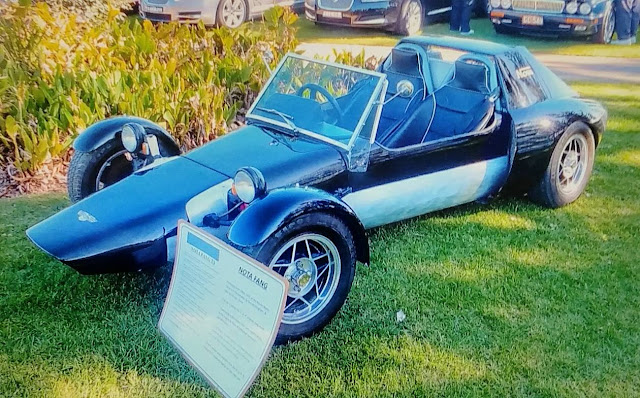Guy Buckingham (1921-2015), is known as the man who introduced low-cost motor sport into Australia with the Formula Vee. This was an inexpensive type of open-wheeled racecar for beginners and privateers using a VW engine, suspension and transmission, devised in 1959.
Buckingham's marque, Nota, played an important role in the bespoke manufacture and maintenance of Australian sports and racing cars. He was also largely responsible for laying out Oran Park raceway and he spoke on racing car tuning and design in a weekly TV show called the Westinghouse World of Sport.
 |
| The Nota badge |
Nota made a name for itself during the halcyon days of budget motor sport, from the 1950s until the 1970s. The company's curious name, Nota Engineering, was inspired by Guy’s son, Chris, who struggled to pronounce 'motor' as a little boy.
The first Nota came out in 1955. By 1970, Guy Buckingham returned to England after passing the reins of the company over to Chris, who learned much from his father and was well equipped to take charge.
 |
| The Nota chassis, at rear |
In 1971 Chris Buckingham built the prototype Nota Type IV which he named the "Fang". The name "Fang", though evocative, doesn’t refer to big teeth. It was a 1960s slang term for driving really fast, inspired by the famous racing car driver, Juan Fangio.
The Nota Fang was designed to fill a niche market for inexpensive sports racing cars at a time when traditional roadsters, such as MGB or Austin Healey, were increasing in cost and luxury. The aim was to produce a sportscar capable of both road and competitive track work that offered racetrack performance and style at a bargain price. In 1971, when it made its debut, it sold for $2000.
 |
| The Nota F1, an evolution of the Fang, at rear |
The chassis consisted of a tubular steel space frame, with a semi-stressed alloy tub section, and an integrated roll bar. Its frame also featured progressively collapsible sections front and rear, and detachable (bolt on) fiberglass paneling.
It used a Mini Cooper S, transverse-mounted engine at the rear, which gave the car a power-to-weight ratio similar to a Ferrari or a Phase III GTHO Ford Falcon. In its original guise, the car only weighed around 1100lbs. Later the Fang was equipped with Lancia engines, then Toyota and Honda engines of 1.8-2 liter displacement.
 |
| The Nota Fang on the track |
The car featured a fully independent suspension, with A-arms at all four corners, with adjustable height and dampening. Early versions of the car used drum brakes, which were later upgraded to a disc fitment.
Between 1971 and 1975 a total of 117 Mini-powered Nota Fangs were manufactured, the firm’s largest production run, putting it amongst the most successful of cars from any Australian specialist automotive manufacturer. Examples are still made to order today.
 |
| The Nota Fang dashboard |
 |
| The Nota Fang cockpit |
 |
| The Nota F1, an evolution of the Fang |
 |
The Nota Fang prototype, with modified rear
bodywork from the F1, at front from above |
 |
| The Nota Fang, driver's side |
 |
| The Nota Fang, left 3/4 view |
 |
| The Nota Fang chassis at rear |
 |
| Cut-away of the Nota Fang |
 |
| A Nota Fang, among family |
 |
| Nota Fang in racing guise |
 |
| Nota Fang, at rear |
 |
| Nota Fang (image from the Bolly Blog) |
 |
| Nota Fang, in racing trim |
 |
| Nota Fang on the track |
 |
| Nota Fang at rear |
 |
| Nota Fang |
 |
| Nota Fang at speed |
 |
| Nota Fang in racing mode |
 |
| Nota Fang in the press. Later versions were optionally Honda powered |




























Comments
Post a Comment